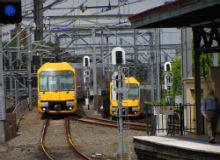

The Australian Rail Track Corporation (ARTC), in collaboration with Lockheed Martin, aims to jump-start the future of railway signalling and communications throughout country. But how will this switch change the rail network?
This new, digital system, called the advanced train management system (ATMS), will display real-time information to the train driver on a display in the cabin. The on-train location system is accurate to 3m.
In terms of a jump forward, it will carry on the replacement of Australia’s system of analogue controls, which use mechanical signals at the track to notify drivers of where on the track is safe to go.
One thing to dispel is the idea that ATMS could be used to eventually replace drivers. Instead, it will, it is claimed, allow trains to work in closer proximity to one another, potentially freeing up more space for greater capacity, perhaps doubling or tripling the amount of freight traffic.
That said, there is the possibility of remote intervention. “ATMS uses GPRS to gather speed and location information from trains and then send instructions to the cabin,” Tim Ryan, ARTC’s executive general manager of enterprise services, told iTnews. “It potentially also allows us [to] intervene remotely if a train is travelling too far or too fast.”
ATMS works by communicating with network control centres and locomotives on the ARTC network, which spans 4430km of standard gauge interstate track. This is done by both voice and data communication, and from this, ATMS can send the signal to the locomotive, denoting that it is safe to carry on its route.
While efficiency is a key element, safety inevitably plays its part. ATMS has been designed to stop a train if a driver does not follow the instructions they are given, but only after providing audio and visual warnings.
From Port Augusta to Whyalla
To assess the new system’s effectiveness, the ARTC has embarked on a ‘shadow’ trial. ATMS is now being used on trains between the South Australian cities of Port Augusta and Whyalla.
“Phase one was effectively laboratory trials of the technology – benchtop testing,” said Ryan. “In phase two, we trialled the system with a Land Rover on tracks. Right now, we’re in phase three, where we’re running ATMS on trains in shadow mode, in parallel to existing signalling.”
But, what comes next? Depending on the success of this trial, ARTC intends to implement the technology across the network, possibly starting in 2017. The line between Tarcoola in South Australia, and Kalgoorlie in Western Australia could be the first to witness this revolution.
Building on Telstra
While ATMS is separate from the wider digitisation plans for the network, it is another step forward and follows on from work started in 2012 to replace communication systems with a new upgrade based on Telstra’s Next G network.
In August 2015, the ARTC agreed a contract with Telstra to provide the 8,500km national freight network with high-speed telecommunications services for the next ten years. Part of this includes 70 base stations on the network, providing 3G voice and data services.
Telstra’s chief customer officer of global enterprise and services, Martijn Blanken, was quoted by ZDNet as saying: “Together with the ARTC’s vision for rail innovation and Telstra’s agile communications network, we have co-created a mobile and cloud-based solution that will help move the national rail freight sector forward.”
According to Ryan, this ever increasing desire for digital has opened up new possibilities, including remote train health monitoring, as well as the aforementioned location information.
Europe: following a similar pattern
Australia’s digital revolution is also being mirrored in Europe as signalling systems start to move into the 21st century.
In the UK, Network Rail is in the early stages of a plan to replace analogue train signals with the European Train Control System (ETCS), which uses wireless technology and computerised in-cabin signals to control the speed of trains across the network.
The ETCS is part of the EU’s European Rail Traffic Management System, which has been introduced in an attempt to standardise railways across the EU. The system is already used on the high-speed TGV lines in France, while in the UK a pilot scheme was introduced on the Cambrian line in Wales.
So, as the UK and Australia undertake their own digital transformations, we are beginning to see the end of the era of traditional track signalling.



